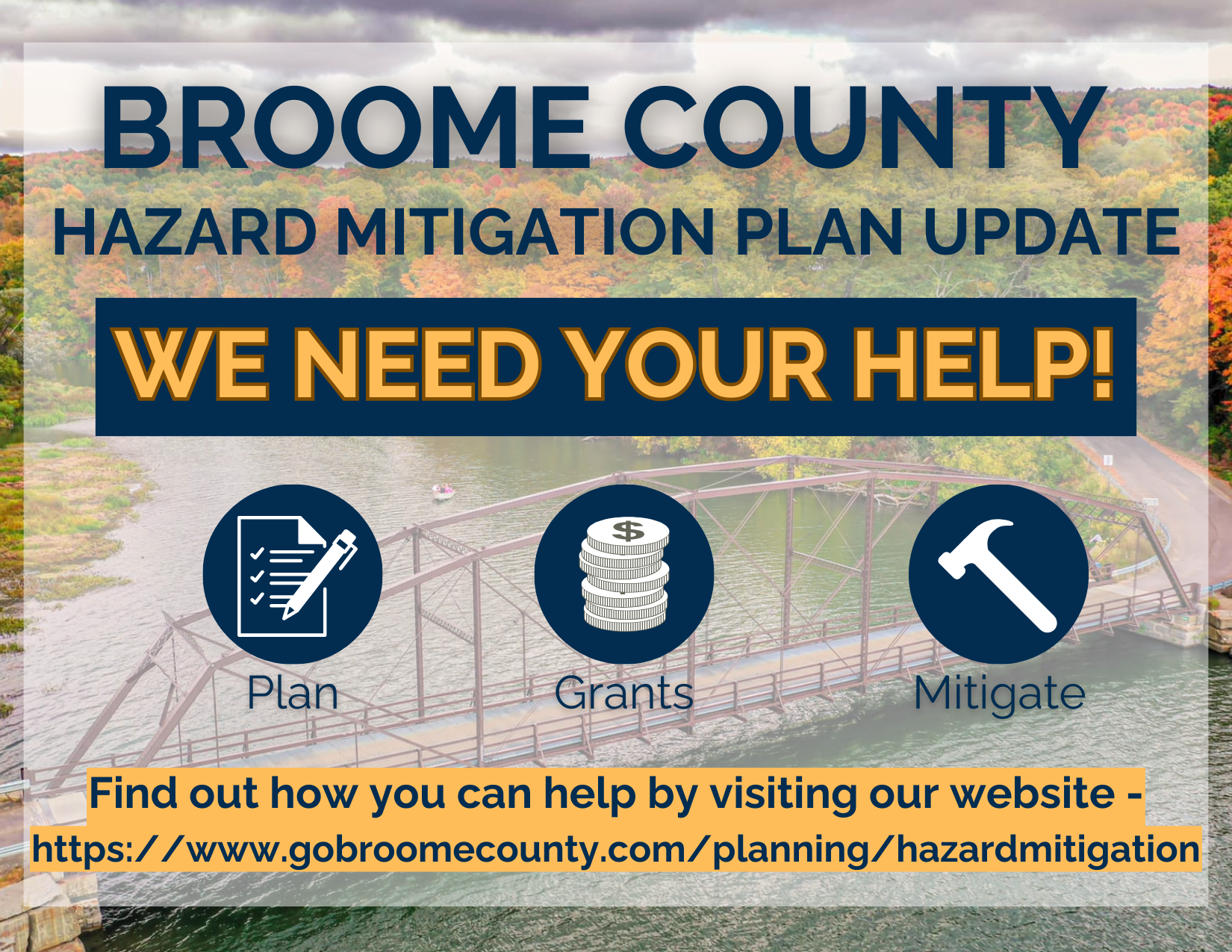View our 2024 Broome County Multi-Jurisdictional Hazard Mitigation Plan Update Draft Plan Here

In 2022, Broome County received a grant from the Federal Emergency Management Agency and the New York State Division of Homeland Security and Emergency Services to update the existing County-Wide Hazard Mitigation Plan (HMP) in cooperation with our partner municipalities. This process will build upon previous efforts to make Broome County and its jurisdictions more resistant and resilient to damages from natural disasters. The plan update is essential in ensuring eligibility for future FEMA pre- and post-disaster grants and will be updated with the support of our contract consultant throughout the year.
This project is made possible with funding from the Federal Emergency Management Agency (FEMA) and New York State Division of Homeland Security and Emergency Services (DHSES).

Check out the 2024 Broome County Multi-Jurisdictional Hazard Mitigation Plan Update Here!
View the 2019 Broome County Hazard Mitigation Plan Here
View the 2013 Broome County Hazard Mitigation Plan Here
Broome County Project Contact:
Stephanie Brewer, Senior Planner
Broome County Planning & Economic Development Department
Stephanie.brewer@broomecountyny.gov
What is Hazard Mitigation?
Disasters can cause loss of life, damage buildings and infrastructure, and have devastating consequences for a community’s economic, social, and environmental well-being. Hazard mitigation is an action taken to reduce loss of life and property by lessening the impact of disasters (natural, technological, and man-made). As the costs of disasters continue to rise, governments and citizens must find ways to reduce hazard risks to communities. Efforts made to reduce hazard risks should be compatible with other community goals; safer communities are more attractive to employers as well as residents. As communities plan for new development and improvements to existing infrastructure, mitigation can and should be an important component of the planning effort. It is often considered the first of the four phases of emergency management – mitigation, preparedness, response, and recovery. Mitigation is an important step in creating a more resilient community.
Local governments have the responsibility to protect the health, safety, and welfare of their residents. Proactive mitigation leads to more cost-effective projects, by contrast, reactive mitigation, tends to lead to severe damage and often more costly fixes; it simply costs too much to address the effects of disasters only after they happen. When a community is more resilient, it has the ability to adapt to changing conditions and prepare, withstand, and rapidly recover from a disaster.
Click Here to Learn More About Hazard Mitigation!
What is a Hazard Mitigation Plan (HMP)?
A hazard mitigation plan (HMP) is “the representation of the jurisdiction’s commitment to reduce risks from natural hazards, serving as a guide for decision makers as they commit resources to reducing the effects of natural hazards” (44 CFR 201.6). Mitigation is most effective when it is based on a comprehensive, long-term plan that is developed before a disaster occurs. The planning process is as important as the plan itself because it creates a framework for governments to reduce the negative impacts from future disasters on lives, property, and the economy.
Hazard mitigation planning can significantly reduce the physical, financial, and emotional losses caused by disasters. The Disaster Mitigation Act of 2000 is federal legislation that establishes a pre-disaster hazard mitigation program and new requirements for the national post disaster Hazard Mitigation Grant Program (HMGP). It encourages and rewards state and local pre-disaster planning and promotes sustainability. Completion of an HMP will result in more effective risk reduction projects and in a faster and more efficient allocation of funding. Click the link below to learn more about the update to the Broome County HMP.
2024 Broome County Multi-Jurisdictional Hazard Mitigation Plan Update
How does the plan benefit Broome County?
A HMP will assist Broome County and its jurisdictions with the following:
- An increased understanding of the natural hazards the County faces
- Development of more sustainable and resilient communities
- Eligibility for federal funds for pre-disaster mitigation planning before disaster strikes
- Potential financial savings to residents, including flood insurance premium reductions
- Reduced long-term impacts and damages to human health and structures, and reduced repair costs
More Resources
Building Resiliency - Update on efforts in Broome County to become a more flood smart community.
Broome County Communities New York Rising Community Reconstruction Plan
Broome County Watershed Flood Hazard Mitigation Plan
- Report
- Appendix A
- Appendix B
